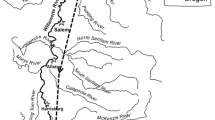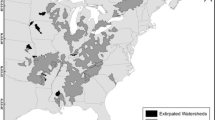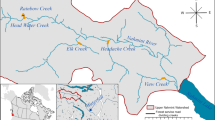Abstract
We used radio telemetry to investigate the freshwater biology of adult Pacific lampreys in the Smith River, a coastal Oregon watershed. We tagged 91 adults at a fish ladder trap (65 km from the ocean) in the spring of 2006–07 and 2009–10. We did not detect a radio-tagging effect on short-term survival and migration rate relative to a PIT-tagged cohort. Fish began migrating April–June and averaged 8.5 km/d. Most were holding by late June, which coincided with the onset of base flow and peak water temperatures. Summer holding locations were distributed 68–146 km from the ocean. Migration distance was inversely related to tagging date but was not related to fish length. Holding fish were strongly associated with glides and boulders as cover. Fish held for about 9 months prior to spawning, although 75 % made at least one upstream movement in winter coincident with high-water events. Individuals began their final migration/spawning phase in March and April, coinciding with increasing temperature and discharge, and were highly vulnerable to predation. Fish that were tagged during the initial migration and held in the upper basin mainly moved downstream to spawn, whereas fish that were tagged during the final migration moved upstream prior to spawning. Some spawned in multiple locations, separated by ≤16 km, and with 1–3 other spawners. The broad distribution of holding and spawning habitat of this population and the diverse needs of individuals suggest that conservation of coastal lamprey populations will require protection and restoration at the watershed level.







Similar content being viewed by others
References
Beamish RJ (1980) Adult biology of the river lamprey (Lampetra ayresii) and the Pacific lamprey (Lampetra tridentata) from the Pacific coast of Canada. Can J Fish Aquat Sci 46:420–425
Beamish RJ, Levings DD (1991) Abundance and freshwater migrations of the anadromous parasitic lamprey, Lampetra tridentata, in a tributary of the Fraser River, British Columbia. Can J Fish Aquat Sci 48:1250–1263
Brumo AF (2006) Spawning, larval recruitment, and early life survival of Pacific lampreys in the South Fork Coquille River. Thesis, Oregon State University, Oregon
Brumo AF, Grandmontagne L, Namitz SN, Markle DF (2009) Approaches for monitoring Pacific lamprey spawning populations in a coastal Oregon stream. In: Brown LR, Chase SD, Mesa MG, Beamish RJ, Moyle PB (eds) Biology, management, and conservation of lampreys in North America, American Fisheries Society, Symposium 72. Bethesda, Maryland, pp 311–321
Chase SD (2001) Contributions to the life history of adult Pacific lamprey (Lampetra tridentata) in the Santa Clara River of southern California. Bull South Calif Acad Sci 100:74–85
Clemens BJ (2011) The physiological ecology and run diversity of adult Pacific lamprey Entosphenus tridentatus, during the freshwater spawning migration. Dissertation, Oregon State University
Clemens BJ, van de Wetering SJ, Kaufman J, Holt RA, Schreck CB (2009) Do summer temperatures trigger spring maturation in adult Pacific lamprey, Entosphenus tridentatus? Ecol Freshw Fish 18:418–426
Clemens BJ, Binder TR, Docker MF, Moser ML, Sower SA (2010) Similarities, differences, and unknowns in biology and management of three parasitic lampreys of North America. Fisheries 35:580–594
Clemens BJ, Mesa MG, Magie RJ, Young DA, Schreck CB (2011) Pre-spawning migration of adult Pacific lamprey, Entosphenus tridentatus, in the Willamette River, Oregon (U.S.A.). Environ Biol Fish. doi:10.1007/s10641-011-9910-3
Clemens BJ, Wyss L, McCoun R, Schwabe L, Courter I, Duery S, Vaughn J, Schreck CB (2012) Migration characteristics and habitat use of the imperiled adult Pacific lamprey in the Willamette Basin: prelude to estimating requirements for persistence. Final draft report to the Columbia River Inter-Tribal Fish Commission. Oregon Cooperative Fish and Wildlife Research Unit, Oregon State University, Corvallis
Close DA, Fitzpatrick M, Li H, Parker B, Hatch D, James G (1995) Status report of the Pacific Lamprey (Lampetra tridentata) in the Columbia Basin. Bonneville Power Administration Project Number 94-026. Portland, Oregon
Close DA, Fitzpatrick MS, Li HW (2002) The ecological and cultural importance of a species at risk of extinction, Pacific lamprey. Fisheries 27(7):19–25
Close DA, Fitzpatrick MS, Lorion CM, Li HW, Schreck CB (2003) Effects of intraperitoneally implanted radio transmitters on the swimming performance and physiology of Pacific lamprey. N Am J Fish Manag 23:1184–1192
Close DA, Currens KP, Jackson A, Wildbill AJ, Hansen J, Bronson P, Aronsuu K (2009) Lessons from the reintroduction of a noncharismatic, migratory fish: Pacific lamprey in the upper Umatilla River, Oregon. In: Brown LR, Chase SD, Mesa MG, Beamish RJ, Moyle PB (eds) Biology, management, and conservation of lampreys in North America, American Fisheries Society, Symposium 72. Bethesda, Maryland, pp 233–254
Cochran PA (2009) Predations on lampreys. In: Brown LR, Chase SD, Mesa MG, Beamish RJ, Moyle PB (eds) Biology, management, and conservation of lampreys in North America, American Fisheries Society, Symposium 72. Bethesda, Maryland, pp 139–151
CRBLTW (Columbia River Basin Lamprey Technical Workgroup) (2005) Critical uncertainties for lamprey in the Columbia Basin: results from a strategic planning retreat of the Columbia River Technical Workgroup. Columbia Basin Fish and Wildlife Authority, Portland OR. http://www.fws.gov/columbiariver/lampreywg/docs/CritUncertFinal.pdf
CRITFC (Columbia River Inter-Tribal Fish Commission) (2011) Tribal Pacific lamprey restoration plan for the Columbia River. Columbia River Inter-Tribal Fish Commission, Portland, OR. http://www.critfc.org/lamprey/lamprey_plan.pdf
Dunn OJ (1964) Multiple contrasts using rank sum tests. Technometrics 6:241–252
Gunckel SL, Jones KK, Jacobs SE (2009) Spawning distribution and habitat use of adult Pacific and Western brook lampreys in Smith River, Oregon. In: Brown LR, Chase SD, Mesa MG, Beamish RJ, Moyle PB (eds) Biology, management, and conservation of lampreys in North America, American Fisheries Society, Symposium 72. Bethesda, Maryland, pp 173–189
Hardisty MW (2006) Lampreys: life without jaws. Forrest Text, Ceredigion
Hardisty MW, Potter IC (1971) The general biology of adult lampreys. In: Hardisty MW, Potter IC (eds) The biology of Lampreys, vol 1. Academic, London, pp 127–206
Hollander M, Wolfe DA (1973) Nonparametric statistical methods. John Wiley & Sons, New York
Keefer ML, Moser ML, Boggs CY, Daigle WR, Peery CA (2009) Effects of body size and river environment on the upstream migration of adult Pacific lampreys (Lampetra tridentata). N Am J Fish Manag 29:1214–1224
Kostow K (2002) Oregon Lampreys: natural history, status, and analysis of management issues. Oregon Department of Fish and Wildlife, Portland
Lampman RT (2011) Passage, migration, behavior, and autoecology of adult Pacific lamprey at Winchester Dam and within the North Umpqua River Basin, OR. Thesis, Oregon State University
Lê B, Luzier C, Collier T (2004) Evaluate habitat use and population dynamics of lampreys in Cedar Creek. Annual Report 2003 from the U.S. Fish and Wildlife Service to the Bonneville Power Administration
Luzier CW, Silver GS (2005) Evaluate habitat use and population dynamics of lampreys in Cedar Creek. Annual Report 2004 from the U.S. Fish and Wildlife Service to the Bonneville Power Administration.
Luzier CW, Schaller HA, Brostrom JK, Cook-Tabor C, Goodman DH, Nelle RD, Ostrand K, Streif B (2011) Pacific lamprey (Entosphenus tridentatus) assessment and template for conservation measures. Portland, Oregon, pp 282
Mesa MG, Copeland ES (2009) Critical uncertainties and research needs for the restoration and conservation of native lampreys in North America. In: Brown LR, Chase SD, Mesa MG, Beamish RJ, Moyle PB (eds) Biology, management, and conservation of lampreys in North America, American Fisheries Society, Symposium 72. Bethesda, Maryland, pp 311–321
Mesa MG, Bayer JM, Seelye JG (2003) Swimming performance and physiological responses to exhaustive exercise in radio-tagged and untagged Pacific lampreys. Trans Am Fish Soc 132:483–492
Michael JH Jr (1980) Repeat spawning of Pacific lamprey. Calif Fish Game 66:186–187
Michael JH Jr (1982) Additional notes on the repeat spawning by Pacific lamprey. Calif Fish Game 70:186–188
Miller RR (2010) Is the past present? Historical splash-dam mapping and stream disturbance detection in the Oregon Coastal Province. Thesis, Oregon State University
Moffett JW, Smith SE (1950) Biological investigations of the fishery resources of Trinity River, California. U.S. Fish and Wildlife Service. Special Scientific Report: Fisheries No. 12
Moore KM, Jones KK, Dambacher JM (2007) Methods for stream habitat surveys: Aquatic Inventories Project. Information Report 2007-01, version 3. Oregon Department of Fish and Wildlife, Corvallis
Moser ML, Mesa MG (2009) Passage considerations for anadromous lampreys. In: Brown LR, Chase SD, Mesa MG, Beamish RJ, Moyle PB (eds) Biology, management, and conservation of lampreys in North America, American Fisheries Society, Symposium 72. Bethesda, Maryland, pp 115–124
Moser ML, Matter AL, Stuehrenberg LC, Bjornn TC (2002) Use of an extensive radio receiver network to document Pacific lamprey (Lampetra tridentata) entrance efficiency at fishways in the lower Columbia River. Hydrobiologia 483:45–53
Moser ML, Ogden DA, Sandford BP (2007) Effects of surgically implanted transmitters on anguilliform fishes: lessons from lamprey. J Fish Biol 71:1847–1852
Moyle PB (2002) Inland fishes of California. University of California Press, Berkeley
Moyle PB, Brown LR, Chase SD, Quiñones RM (2009) Status and conservation of lampreys in California. In: Brown LR, Chase SD, Mesa MG, Beamish RJ, Moyle PB (eds) Biology, management, and conservation of lampreys in North America, American Fisheries Society, Symposium 72. Bethesda, Maryland, pp 279–272
Nawa R (2003) A petition for rules to list: Pacific lamprey (Lampetra tridentata); river lamprey (Lampetra ayresi); western brook lamprey (Lampetra richardsoni); and Kern brook lamprey (Lampetra hubbsi) as threatened or endangered under the Endangered Species Act. Letter to the U.S. Fish and Wildlife Service, Department of the Interior
Renaud CB (1997) Conservation status of Northern Hemisphere lampreys (Petromyzontidae). Appl Ichthyol 13:143–148
Robinson TC, Bayer JM (2005) Upstream migration of Pacific lampreys in the John Day River, Oregon: behavior, timing, and habitat use. Northwest Sci 79:106–119
Seber GAF (1982) The estimation of animal abundance and related parameters. Edward Arnold, London
Sedell JR, Duval S (1985) Influence of forest and rangeland management on anadromous fish habitat in western North America: water transportation and storage of logs. USDA United States Forest Service General Technical Report GTR-PNW-186. Pacific Northwest Research Station, Portland
Sedell JR, Froggatt JL (1984) Importance of streamside forests to large rivers: the isolation of the Willamette River, Oregon, USA, from its floodplain by snagging and streamside forest removal. Proc Int Assoc Theor Appl Limnol 22:1824–1834
Sokal RR, Rohlf FJ (1995) Biometry: the principles and practice of statistics in biological research, 3rd edn. W. H. Freeman and Co, New York
Stone J (2006) Observations on nest characteristics, spawning habitat, and spawning behavior of Pacific and Western brook lamprey in a Washington stream. Northwest Nat 87:225–232
Stone J, Sundlov T, Barndt S, Coley T (2003) Evaluate habitat use and population dynamics of lampreys in Cedar Creek, Annual Report 2002 from the U.S. Fish and Wildlife Service to the Bonneville Power Administration
Streif B (2009) Considering Pacific lampreys when implementing instream activities. In: Brown LR, Chase SD, Mesa MG, Beamish RJ, Moyle PB (eds) Biology, management, and conservation of lampreys in North America, American Fisheries Society, Symposium 72. Bethesda, Maryland, pp 255–268
Suring E, Leader KA, Lorion CM, Miller BA, Wiley DJ (2009) Salmonid life cycle monitoring in Western Oregon streams, 2006–2008. Monitoring Program Report Number OPSW-ODFW-2009-2. Oregon Department of Fish and Wildlife, Salem
Torgerson CE, Close DA (2004) Influence of habitat heterogeneity on the distribution of larval Pacific lamprey (Lampetra tridentata) at two spatial scales. Freshw Biol 49:614–630
USFWS (U.S. Fish and Wildlife Service) (2004) Endangered and threatened wildlife and plants; 90-day finding on a petition to list three species of lampreys as threatened or endangered. Federal Register 69:247(27 December 2004):77158
Whyte JNC, Beamish RJ, Ginther NG, Neville CE (1993) Nutritional condition of the Pacific lamprey (Lampetra tridentata) deprived of food for periods of up to two years. Can J Fish Aquat Sci 50:591–599
Wissmar RC, Smith JE, McIntosh BA, Li HW, Reeves GH, Sedell JR (1994) A history of resource use and disturbance in riverine basins of eastern Oregon and Washington (early 1800s–1990s). Northwest Sci 68:1–35
Zar JH (1999) Biostatistical analysis. Prentice-Hall, Upper Saddle River
Acknowledgments
This project was funded by the U.S. Fish and Wildlife Service and Oregon Conservation Strategy. We are grateful for field assistance from Mike Hogansen, Michael Scheu, Kay Abel, Trent Hartill, Patrick Hayden, and Shannon Richardson (Oregon Department of Fish and Wildlife [ODFW]), and volunteer Rochelle Herness-Leitz. We thank Stan van Wetering (Confederated Tribes of the Siletz Indians) and Eric Suring (ODFW) for thermograph data; Jerry Smith (Oregon State Parks) for seasonal housing; Aaron Jackson and Mary Moser for advice and training in surgical techniques; and Sam Moyers, Holly Truemper, and Pete Baki (ODFW) for assistance with trapping in the fish ladder at Smith River falls. Shaun Clements (ODFW), Ben Clemens (ODFW), Abel Brumo (Stillwater Sciences), and two anonymous reviewers provided useful comments to earlier versions of this manuscript. This study was conducted following internal review and in adherence to standard operating procedures of appropriate animal care of the Oregon Department of Fish and Wildlife.
Author information
Authors and Affiliations
Corresponding author
Rights and permissions
About this article
Cite this article
Starcevich, S.J., Gunckel, S.L. & Jacobs, S.E. Movements, habitat use, and population characteristics of adult Pacific lamprey in a coastal river. Environ Biol Fish 97, 939–953 (2014). https://doi.org/10.1007/s10641-013-0196-5
Received:
Accepted:
Published:
Issue Date:
DOI: https://doi.org/10.1007/s10641-013-0196-5




